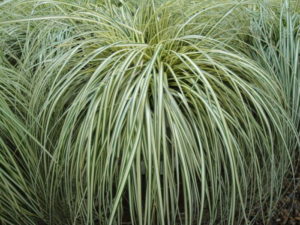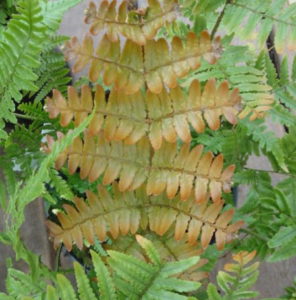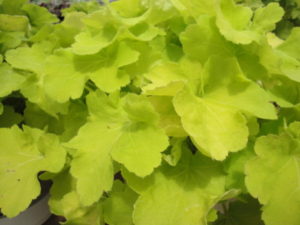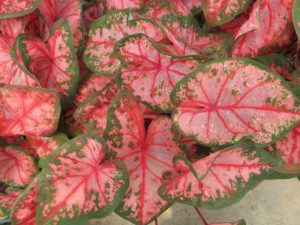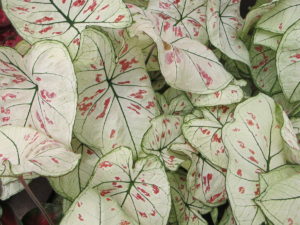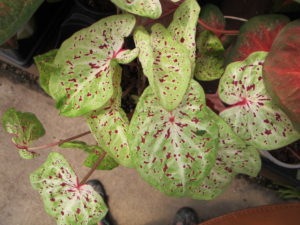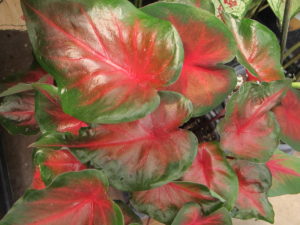Page 2
Perennials for Your Shady Porch Planter
It’s time to look around the garden center for plants that will take shade. Your geraniums hardly flowered at all last year, and so many of the leaves turned yellow. The porch overhang might allow an hour of early morning sun or setting sun, but that’s simply not enough for the sun lovers.
You’ve tried assorted “partial sun” plants, but they never thrived in limited light. Part sun means about 4 hours of direct sunlight, although most “partial sun” labels refer to plants that need more sun than that…or sometimes less, so you have to know that variety’s requirements. I’ve seen scabiosa, dianthus, and dusty miller labeled as part sun plants, which they are not. And you know that spot for your porch planter won’t get 4 hours of sun.
As the arc of the sun changes from one season to the next, you might see that your porch gets more direct sunlight in winter. That sunny but protected spot would welcome a colorful planter, and might support plants that wouldn’t grow in summer’s shade (viola, curly parsley).
Start with a larger pot than you’d use for the tropical ferns or the miniatures listed above, maybe 14″ or more in diameter. The perennials will bulk up to larger proportions. Larger pots give you more room to get creative with combinations, and plants in larger pots are less susceptible to alternating freeze/thaw damage. Look around the Perennial and Ground Cover Departments at garden centers for suitable green or colorful foliage.
- Autumn fern, Dryopteris erythrosora ‘Brilliance’.
- Heuchera ‘Citronelle’.
Some Possibilities
- coral-bells (Heuchera ‘Citronelle’, ‘Caramel’, or ‘Champagne’, etc.) Dark purple and black varieties prefer stronger sun. These have bold, rounded leaves. Tall airy flower spikes are secondary to the foliage, but still pretty.
- foamflower (Tiarella cultivars), related to Heuchera. Intergeneric crosses between Heuchera and Tiarella (X Heucherella) offer more choices. Many undergo incredible color changes as the temperature drops.
- autumn fern (Dryopteris erythrosora ‘Brilliance’ and ‘Radiance’) is a hardy evergreen. It grows 14″ to 24″ tall, and new fronds are copper or burgundy in color. Color plays well with other warm colors. Transplant to the shady garden when it grows too large, or divide it.
- Japanese painted fern (Athyrium nipponicum cultivars) is herbaceous, so it dies down to the ground in winter. It has grayish green foliage with lighter markings, and a purple midrib. Nice in a cool color palette. Finely dissected fern foliage contrasts with the bold heucheras.
- hosta. Thousands of cultivars offer variations in size (from 2-3″ tall to 3′ tall), color, and shape. Try pairing a dwarf blue hosta with a Japanese painted fern. Hostas are herbaceous.

Flowers on Hosta ‘Halcyon’.
And More Possibilities
- English ivy, such as yellow variegated ‘Gold Child’ or white variegated ‘Kolibri’, trails over the sides and tolerates frosty weather. ‘Spetchley’ and ‘Duckfoot’ are tiny-leaved trailers. Evergreen. Cut back if overgrown; large woody clumps will need to be divided.
- miniature euonymus with tiny leaves, small-leaved Vinca minor (with white or yellow margins), and golden creeping jenny (Lysimachia nummalaria ‘Aurea’) in morning sun.
- something grassy. Ophiopogon, Carex, and Juncus offer many colorful varieties for fine-textured contrast. Carex ‘Evergold’ and C. ‘Everillo’ add mounding chartreuse leaves that cluster over the rim of the porch planter. Bright shade to part sun.
- and any other plant that pleases you, grows in mostly shade, and plays well with others. Pachysandra (evergreen; green and variegated varieties) would work. Try a young Japanese maple (nice branching, very hardy).
Take a trip to a couple of garden centers or plant festivals to see what’s out there. Promise cooperative kids a nice lunch at their favorite restaurant…or their very own fairy garden.
A New Appreciation
Learning to appreciate texture, foliage color, and contrasts are key to a successful shady porch planter. These are the elements of a satisfying design:
- varying growth habits (upright fern, mounding Heuchera, trailing ivy, grassy filler, for example)
- proper placement in the pot—tall plants toward the back if the planter will be placed against a wall, or central if viewed from all sides
- contrasting textures—bold to fine
- a related color scheme
- plants that share the same growing conditions (light, water, soil pH)
- and a complementary container
Color for a Porch Planter
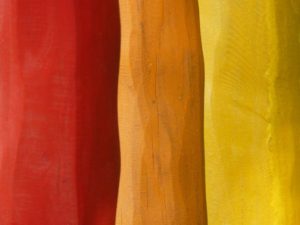
In general, warm colors (warm red, orange, yellow, cream) look good together, and cool colors (purple, blue, pink, silver) look good together. The colors within each of those two groups are adjacent to each other on the “color wheel”. A color such as burgundy can have either a cool (blue) influence or a warm (scarlet red) influence. (At the bottom of this page, you’ll find more information on using color.)
Before planting, hold a burgundy-leaved plant (Phormium, Cordyline, Heuchera) next to some other colors to see which combinations look best. Try a peach-colored Begonia boliviensis with burgundy and something white. If using warm peach, I would avoid cool baby-girl pink in the same pot.
Add white, if in doubt; white calms the color riot. For years, I kept pale pink, pale yellow, and white water lilies in my goldfish pond; the addition of white to the pastels created a calm, peaceful picture.

Of course, certain pairings of warm and cool colors in the same pot look just wonderful. Colors opposite each other on the color wheel (complementary colors) are fine: yellow and deep purple make a bold pair, as do light orange or coral and vibrant blue. But a rust-colored mum with a hot pink dianthus…not so good. To me, anyway.
That’s what it comes down to. If you like those plants together, then go for it! But look closely at the colors if there’s something not quite right, something indefinable. It might be as simple as substituting a warmer peach color for the bubblegum pink. Or perhaps your porch planter needs an “exclamation point” (the thriller), or something grassy for textural contrast.
Getting the Whole Picture
Don’t forget to consider colors in the nearby surroundings, such as the brick or siding, the door, landscaping near the porch, and the house trim. Choose pot colors that complement these colors. Employing color echoes effectively ties together all the components in your garden.
The colors of the surroundings and of the pot will help you select a well-designed color scheme for the plants. Now, step back and imagine the whole picture, not just the parts.
Year-Round Gardening In a Porch Planter
Warm Weather
Tuck in a Caladium (photos, above) for gorgeous summer color and pattern. Snip off their spathe-like flowers to direct energy into foliage production. For healthy growth all summer, fertilize caladium every 2 or 3 weeks. Well-fertilized caladiums in moist soil can grow quite large, so try to find smaller varieties. Look for a “de-eyed” caladium, which has had the main bud removed from the center of the corm. That forces many of the secondary buds to grow, resulting in a higher quality, leafier, and sometimes shorter plant.
Other ideas for summer color in shady planters can be found in cape primrose (a few species of Streptocarpus), Anthurium, Rex begonia, ‘Non-Stop’ begonia, and those newer South American begonias, like B. boliviensis. Rex and rhizomatous begonias and some of the coleus varieties (some direct sun) offer more opportunities for foliage color combinations.
Mix it up! Some of your houseplants can be incorporated into your pots, and then moved back indoors in the fall. Bromeliads, dracaenas, alocasias, and ‘Neon’ pothos can be inserted into porch planters. Ask for advice at the garden center or the farmers’ market. And experiment a little!
Cool Weather
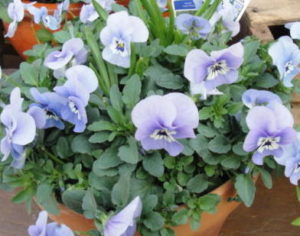
Blue violas.
Replace summer plants with a few biennial violas in the fall. With enough hours of direct sunlight from fall through spring, the violas will bloom beautifully. Sun that would burn an autumn fern in the summer is tolerated in cold weather. Violas, by the way, will bloom with fewer hours (4 or 5 hours or more) of direct sun than pansies.
The advantage of using cold-hardy perennials in shade planters is that they can be on display, in areas with moderate winters, 12 months of the year. Scoop out tender or weakened plants that are no longer appropriate for the season and replace with those that are.
Purchase pots that are frost-resistant if you want to enjoy fall and winter combinations. Depending on the tree canopy, orientation to the sun, and the position of structures, your porch can have vastly different growing conditions from season to season.
Evergreens
Finally, where some height is needed, shade-tolerant upright shrubs and even cut branches from the garden can be used to give the planter greater presence, drawing the eye upward. Many garden centers stock 1- or 2-gallon hardy evergreens for the purpose. Look for holly, arborvitae, pieris, chamaecyparis, and cypress.
Be careful when planting container combinations with evergreens. Survival depends on the roots’ ability to tolerate the colder conditions above ground. When planted in the garden, roots are protected by the surrounding soil, where the temperature is always higher than the air temperature. In general, it’s probably safe to use a shrub that is rated 2 USDA hardiness zones colder than your porch. So, a zone 5 holly should survive in a pot in a zone 7 region. This rule of thumb also applies to perennials.
Ready-Made or DIY Porch Planter?
Check with your garden center to see what they have in ready-to-purchase mixed planters or compose one yourself. You can find more suggestions for color groupings in paint chip brochures while shopping at your favorite paint store. In fact, this is a great starting point for a course in color studies.
In the absence of a cool waterfall out the back door, sitting on the porch can be made more appealing by including a beautiful shade planter. Now, would you like lemon and mint with your tea?
Headings
Page 1: A Shady Porch Planter, But If It Goes Too Dry…, Following the Path of Least Resistance, Ferns and Friends—Made for Shade (So Many Choices), and Small Scale Gardening In a Porch Planter (Little Plants for Sun)
Page 2: Perennials for Your Shady Porch Planter (Some Possibilities), Color for a Porch Planter, Getting the Whole Picture, Year-Round Gardening In a Porch Planter (Warm Weather, Cool Weather, Evergreens), and Ready-Made or DIY Porch Planter?
